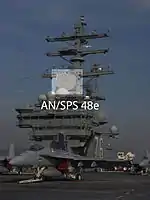AN/SPS-48
The AN/SPS-48 is a US naval electronically scanned array air search three-dimensional radar system manufactured by ITT Exelis and deployed in the 1960s as the primary air search sensor for anti-aircraft warships. The deployment of the AN/SPY-1 and the end of the Cold War led to the decommissioning of many such ships, and many of these vessels AN/SPS-48 sets were reused on aircraft carriers and amphibious ships, where it is used to direct targets for air defense systems such as the Sea Sparrow and RIM-116 SAM missiles. Existing sets are being modernized under the ROAR program to AN/SPS-48G standard for better reliability and usability.
 An SPS-48E radar antenna (the large square panel) aboard USS Theodore Roosevelt (CVN-71). | |
| Country of origin | United States |
|---|---|
| Type | 3D Air-search |
| Frequency | E and F band (2 to 4 GHz) |
| Range | 250 nmi (460 km) |
| Altitude | 100,000 ft (30,000 m) |
| Diameter | 17 ft (5.2 m) by 17 ft 6 in (5.33 m) |
| Azimuth | 0-360° |
| Elevation | 0-65° |
| Precision | 690 ft (210 m) elevation 1/6° azimuth |
| Power | 35 kW (avg) |

Operation
A three-dimensional radar is mounted on a base that allows for 360 degrees of rotation. The target can be located at a given azimuth. The range of the target is also identified due to the time it takes the beam to go out and back to the receiver. What makes this radar system different is its ability to detect the height of the target above the surface of the water. With these three pieces of data the radar's central processor has the ability to place the target in an X,Y,Z, 3 dimensional space.
For the SPS-48 in particular, the antenna is mechanically rotated to scan azimuth, while beams are electronically steered to cover elevation by varying the transmitter frequency.[1] The 4,500 lb (2,000 kg) antenna is capable of rotating at 7.5 or 15 rpm.
According to ITT Exelis,[2] the system has a range exceeding 200 nmi (370 km) and can track targets up to 69 degrees in elevation. The AN/SPS-48E is capable of providing target range, bearing and altitude information using a frequency-scanning antenna using a range of different frequencies in E band and F band with three power modes: high, medium and low. SPS-48 radars stack multiple beams in a train of pulses at different frequencies. The beams scan different elevation areas, allowing the stack to cover up to 69 degrees of elevation.
History
The first specification for what became AN/SPS-48 (and the complementary AN/SPS-49) was written in 1956. The AN/SPS-48 replaced AN/SPS-39 on the Belknap, Coontz and Leahy classes between 1967 and 1975 under the Guided Missile Frigate Anti-Air Warfare Modernization Program. The AN/SPS-48E included a digital receiver and signal processor that could automatically detect and track very small targets, even when jammed. It was included in the New Threat Upgrade of the 1980s.
The AN/SPS-48G program addresses problems of long-term obsolescence through a system redesign that improves the radar's reliability, maintainability, and supportability through technology improvements, open architecture (OA) design, and improved logistics processes while reducing lifecycle cost. It only affects the layout of the below-deck units. The plan is to back-fit the existing AN/SPS-48E population from 2011 through 2020, with the SPS-48G units. They will support fleet 3D air search requirements through 2050 and beyond for the ship classes that have SPS-48G. The earlier 1st and 2nd stage RF amplifiers are replaced with a solid state transmitter and the receiver, processor, and Auxiliary Detection Processor, formerly housed in individual equipment cabinets, are combined into a single cabinet. The number of Lowest Replaceable Units is reduced by 87%, and mean time between critical failure is improved over the AN/SPS-48E(V) by 104%. The new commercial off-the-shelf (COTS) radar processor's computing capabilities will be sustained through a planned tech-refresh program. More intuitive and interactive built-in-test and embedded maintenance and operator training makes available all radar technical, engineering, and logistics data and allows remote monitoring and distance support, while ensuring accurate and timely configuration management.[1]
Uses
With the air targets exact 3D location it is available for interception/removal via either the ship's weapon system or through linked weapons platforms located elsewhere. It is the predecessor of the AEGIS system currently in use on Arleigh Burke-class destroyers and Ticonderoga-class cruisers. The AEGIS AN/SPY-1B/D radars are electronically scanned phased arrays, while the SPS-48E is frequency scanned in elevation, and mounted on a rotating joint that spins the radar in azimuth. The AN/SPS-48 is carried by US Navy ships such as Nimitz-class aircraft carriers, Wasp-class amphibious assault ships, Tarawa-class amphibious assault ships and San Antonio-class amphibious transport docks.
Variants
_radar.jpg.webp)
- AN/SPS-48A -
- AN/SPS-48B - Unknown, possible non-existent or prototype for -48C
- AN/SPS-48C - -48A with Automatic detection and tracking capability as well as Moving target indicator (MTI) capability.
- AN/SPS-48D - Prototype version of -48E, tested on USS Mahan (DDG-42).
- AN/SPS-48E - Compared to the C variant, the SPS-48E has twice the radiated power, increased receiver sensitivity, four stage solid-state transmitter, half the components of a -48C and built-in testing for easier diagnostics. Originally developed as part of the New Threat Upgrade (NTU) Program to support the SM-2 Launch On Search (LOS) capability.
- AN/SPS-48E LBR Land based radar version.
- AN/SPS-48G - some new-build, others upgraded AN/SPS-48E under the Radar Obsolescence, Availability Recovery (ROAR) program. 29 radars are being modernized at a cost of $169.3 million under contract N00024-09-C-5395. Replacing below-decks units with modern electronics based on open architecture will reduce training demands and improve reliability.[1]
See also
- List of radars
- Diffraction grating
- Selex RAN-40L Radar of similar function used in some aircraft carriers.
References
- "United States Navy Factfile AN/SPS-48G". Naval Sea Systems Command. 24 October 2012.
- "ITT Exelis - The Power of Ingenuity". Exelisinc.com. 2011-10-27. Retrieved 2012-10-01.
External links
- NAVAIR Warfighter encyclopedia
- Manufacturer's website
- FAS AN/SPS-48C
- Fire Controlman Volume 02-Fire Control Radar Fundamentals (Revised)
- Dunnigan, James F. (1990). Dirty Little Secrets: Military Information You're Not Supposed To Know. HarperCollins. p. 210. ISBN 978-0-688-11270-7.
